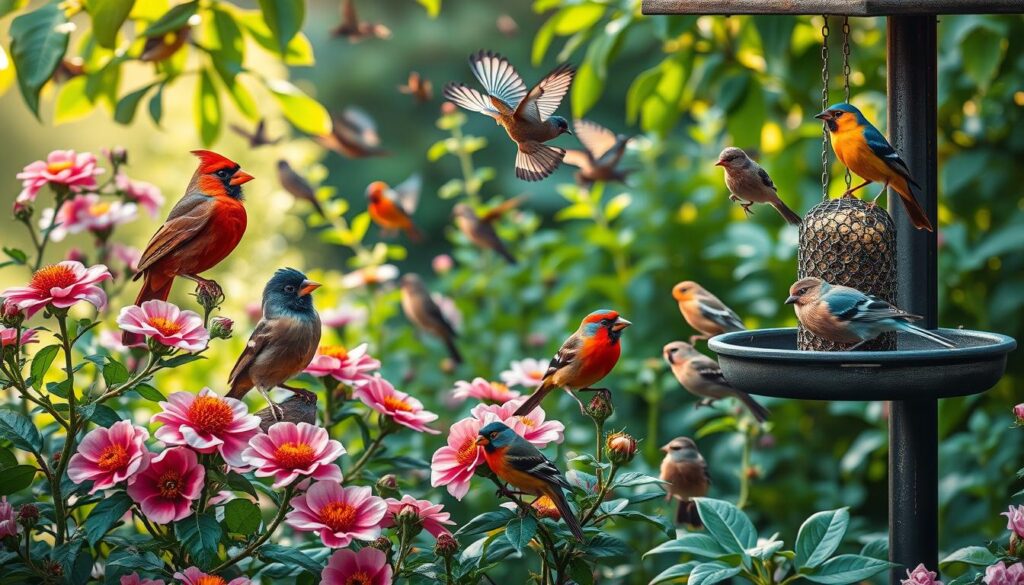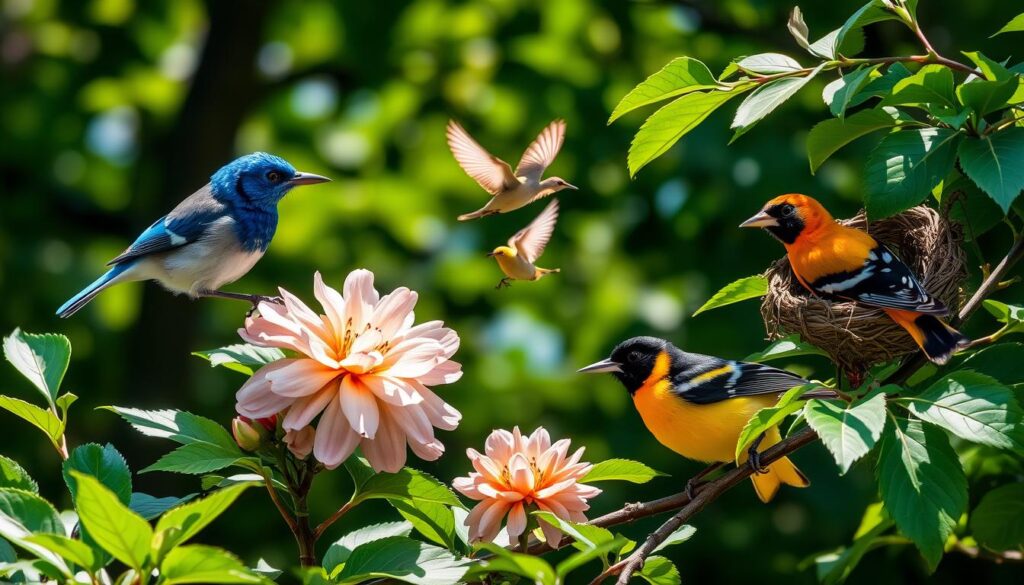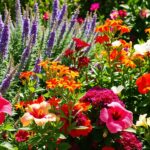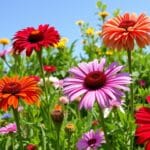Did you know New York City alone has about 350 bird species all year round? This shows how diverse garden birds in New York State are. It’s a dream spot for those who love watching birds in their backyards.
New York’s garden birds are a sight to see, from the bright Northern Cardinal to the agile White-breasted Nuthatch. The state’s mix of city parks and rural areas supports many bird species. This makes New York perfect for both casual bird watchers and experts.
Exploring New York’s garden birds shows how important it is to make our yards bird-friendly. By offering food, water, and shelter, we can draw many birds to our gardens. This not only brings us closer to nature but also helps local bird populations thrive.
Key Takeaways
- New York City hosts about 350 bird species throughout the year
- The Eastern Bluebird is New York’s official state bird
- Black-capped Chickadee is the top feeder bird in New York
- Urban bird feeding is popular, even on apartment balconies
- Creating bird-friendly gardens supports local avian populations
- New York State is home to over 240 breeding bird species
Introduction to New York’s Garden Birds
New York’s gardens are full of different birds, making them a great place for birdwatching. Our state is home to over 240 breeding birds and 450 species all year round. This variety makes birdwatching fun in every season.
The Diversity of Avian Species in New York State
New York has a wide range of birds, from colorful warblers to big raptors. In spring and fall, the skies fill with many species. The New York Botanical Garden is a great place to see birds like Wood Ducks and Red-tailed Hawks.
| Season | Birding Productivity | Notable Species |
|---|---|---|
| Spring Migration | ✸✸✸ | Over two dozen warbler species |
| Summer | ✸✸ | Wood Ducks, Red-tailed Hawks |
| Fall Migration | ✸✸✸ | Broad-winged Hawks |
| Winter | ✸✸ | Black-capped Chickadee, Tufted Titmouse |
The Importance of Backyard Habitats
Backyard habitats are key to supporting many birds. By making our gardens bird-friendly, we help both local and migrating birds. Native plants are great for attracting many birds to my garden.
New York’s Official State Bird: The Eastern Bluebird
In 1970, the Eastern Bluebird became New York’s state bird. This bird is a symbol of our bird heritage. With its bright blue feathers and happy song, it’s a favorite in gardens everywhere.
By taking care of our gardens and enjoying the birds, we help protect New York’s bird life.
Common Garden Birds in New York
New York’s gardens are home to many beautiful birds. In my backyard, I’ve seen three birds often: the American Robin, Northern Cardinal, and Blue Jay. Let’s explore these birds that make our gardens lively and colorful.
American Robin: The Harbinger of Spring
The American Robin is a medium-sized bird, 8″ to 11″ long. It’s known for its bright orange-red breast and gray-black head. I often see these birds searching for worms and insects in my lawn.
Their cheerful song signals spring’s arrival in New York. It’s a welcome sound after winter.
Northern Cardinal: A Splash of Red
The Northern Cardinal brightens any garden with its vibrant red. Males are bright red, while females have reddish-brown feathers. Both have a distinctive crest and black mask.
These 8″ to 9″ birds visit my feeders often, especially in winter.
Blue Jay: The Colorful Noisemaker
Blue Jays are large and known for their bright blue feathers and crest. They range from 10″ to 12″ long. I enjoy watching their intelligent behavior and various calls.
Though they can be loud, their presence adds energy to my backyard.
| Bird Species | Length | Distinctive Features |
|---|---|---|
| American Robin | 8″ – 11″ | Orange-red breast, gray-black head |
| Northern Cardinal | 8″ – 9″ | Bright red plumage (male), crest, black facial mask |
| Blue Jay | 10″ – 12″ | Vibrant blue feathers, conspicuous crest, loud calls |
These common backyard birds bring joy and beauty to New York gardens all year. By making our gardens bird-friendly, we can enjoy their company and help protect them.
Seasonal Birds in New York Gardens
New York gardens change with the seasons, welcoming many migratory birds all year. Winter birds bring life to the quiet landscape. Summer birds add colors and songs to our gardens.
In Central Park, bird lovers can see almost 200 different species all year. This park, with its 843 acres of different places, is a key stop for birds on their journeys.
Winter wrens visit city parks like Central Park and Prospect Park. They come in October and go south for the cold months. In winter, they eat insects and berries, changing their diet for the season.
Spring and fall are when birds move the most, going between Latin America and Canada. Warm spring winds and northwest fall breezes mean more birds around, making these great times for watching birds.
| Season | Notable Birds | Behavior |
|---|---|---|
| Winter | White-throated Sparrows, Long-eared Owls | Seek shelter, rely on feeders |
| Spring | Various warblers, thrushes | Courtship, nest-building |
| Summer | Piping Plovers, Winter Wrens (breeding) | Nesting, raising young |
| Fall | Raptors, shorebirds | Preparing for migration |
Enjoying the birds’ seasonal visits is great, but we must respect their space. Creating bird-friendly gardens helps support these visitors. This way, they can keep coming back.
Garden Birds: Identifying and Attracting Native Species
Attracting and identifying garden birds is a fun hobby. In Massachusetts, where many homes are near nature, it’s important to make gardens bird-friendly. This helps support local birds.
Bird Identification Techniques
Identifying birds means looking at their crown, throat, wing bars, and eye ring. Being patient and using a good field guide helps a lot. For example, bluebirds are easy to spot in open fields with nesting boxes high off the ground.
Creating Bird-Friendly Garden Spaces
To make a garden bird-friendly, I focus on food, water, and shelter. In winter, I use sunflower seeds in feeders for energy. In warmer months, I have nectar, insects, fruits, and berries for them.
Keeping a shallow birdbath with water under 2 inches is important for small birds.
Native Plants That Attract Birds
Native plants are great for attracting birds. I’ve planted things that give hummingbirds nectar, which they start to look for in early May. Ornamental grasses and shrubs give them places to nest and hide.
Leaving some areas wild with leaf litter brings in birds like sparrows and robins. By making my garden diverse, I’ve seen more birds, including colorful ones like vireos and warblers.
| Season | Bird Needs | Garden Provisions |
|---|---|---|
| Winter | High-energy food | Sunflower seeds in feeders |
| Spring/Summer | Breeding resources | Nectar, insects, fruits, berries |
| Year-round | Water | Shallow birdbath, moving water feature |
Feeding Garden Birds in New York
I enjoy bringing different birds to my garden in New York. It’s important to know about bird feeders, food, and their eating habits. This helps make our gardens a friendly place for them.
Types of Bird Feeders
Choosing the right bird feeder is key to attracting many species. Here are some top choices:
- Tube feeders: Great for small birds like finches
- Hopper feeders: Ideal for cardinals and jays
- Platform feeders: Perfect for ground-feeding birds
- Suet feeders: Attract woodpeckers and nuthatches
Seasonal Feeding Habits
Birds need different foods at different times of the year. In winter, I give them high-energy foods like sunflower seeds and suet. Spring and fall are key times for migrating birds, so I offer a mix of seeds and fruits.
Summer feeding is less needed as birds find plenty of food naturally. But hummingbirds and goldfinches need feeders all year.
Best Food Options for Different Bird Species
Offering a variety of foods brings in many birds. Here’s a quick guide:
| Bird Species | Preferred Food |
|---|---|
| Cardinals | Sunflower seeds, safflower seeds |
| Chickadees | Black oil sunflower seeds, suet |
| Hummingbirds | Nectar (1 part sugar to 4 parts water) |
| Woodpeckers | Suet, peanuts |
Always clean feeders often and put them in safe spots to avoid bird crashes. By offering different foods and keeping feeders clean, you’ll make a great bird haven in your New York garden. Just like ants are important in ecosystems, birds are key to our garden’s health.
Bird Watching Tips for New York Gardens

I love birdwatching in New York gardens. With 340 bird species recorded in Manhattan alone, there’s always something exciting to see. Let me share some birding techniques that have helped me spot amazing birds right in my backyard.
Early mornings are prime time for garden birding. I grab my binoculars and settle in quietly. Patience is key – the birds will come! I keep a journal to track species I’ve seen and their behaviors. This helps me learn their patterns and improve my identification skills.
Creating a bird-friendly garden has boosted my birdwatching success. I’ve planted native species that attract local birds and set up different types of feeders. This variety brings in everything from colorful warblers to majestic hawks.
“Birdwatching connects us with nature right in our own backyards. It’s a window into the incredible diversity of life in New York.”
Here’s a quick guide to some common garden birds you might spot:
| Bird Species | Identifying Features | Best Time to Spot |
|---|---|---|
| American Robin | Red breast, gray back | Spring and summer |
| Northern Cardinal | Bright red plumage (male) | Year-round |
| Blue Jay | Blue crest, noisy call | Year-round |
| Ruby-throated Hummingbird | Tiny size, hovering flight | Late spring to early fall |
Remember, birdwatching is about enjoying nature. Take your time, be quiet, and you’ll be amazed at the avian world right outside your door. Happy birding!
Conservation Efforts for Garden Birds in New York
New York’s garden birds face many challenges, but there’s hope. Through dedicated efforts, we can help protect them.
Threats to Local Bird Populations
Urban development is a big threat to New York’s birds. Every year, 90,000 to 230,000 migrating birds die from hitting building glass in New York City. Habitat loss and climate change make things worse.
How to Contribute to Bird Conservation
We can all help protect bird habitats. New York City has 30,000 acres of forests, grasslands, wetlands, and islands perfect for birds. By making bird-friendly gardens and supporting local groups, we make a big difference.
Local Organizations Supporting Bird Habitats
The NYC Bird Alliance has protected wading birds, shorebirds, and waterfowl in New York City’s wetlands and coasts for 40 years. They have professional scientists who study the city’s birds and habitats.
Audubon’s New York City programs teach over 2,000 youth and community members. Their “For the Birds!” program teaches elementary and middle school students. The LARK program helps underrepresented communities with internships, classroom lessons, and a Youth Leadership Council.
Supporting these groups and their programs can help ensure a better future for New York’s garden birds.
Unique and Rare Garden Birds in New York

New York gardens are hotspots for rare bird sightings. We’ve seen 34 confirmed and 8 unconfirmed observations. This means 44% of these sightings are exotic birds, making each visit a chance to discover something new.
The Anna’s Hummingbird is a rare find in our gardens. It’s tiny, weighing only 2.8 to 5.7 grams. Since the 1950s, it has been moving into our area, delighting bird lovers like me.
The Rufous Hummingbird was seen near Syracuse in 2021. It’s a small bird with a big wingspan of 11 cm. This bird travels up to 4000 miles each year, making it a long-distance flyer.
“Every garden bird sighting in New York is a potential rare find. Keep your eyes peeled and your feeders full!”
The Ruby-Throated Hummingbird is another interesting bird in our gardens. It’s one of only four hummingbird species that breed here. Even though it’s small, it’s very protective of its flowers and will chase away larger birds.
These birds face threats like losing their homes and hitting windows. By making our gardens bird-friendly, we can help protect these rare and lovely birds.
The Role of Garden Birds in New York’s Ecosystem
Garden birds are key to New York’s ecosystem. They play a big part in keeping our environment healthy and balanced. These birds do more than just make our gardens look nice; they help with ecosystem services and bird ecology.
Pollination and Seed Dispersal
Birds help with pollination and seed dispersal. Hummingbirds move pollen from flower to flower. Larger birds eat fruits and berries, then drop seeds in new places. This helps plants grow and forests recover.
Pest Control Benefits
Birds control pests naturally. I’ve seen robins and sparrows eat insects, keeping gardens safe. This cuts down on the need for harmful pesticides, making our ecosystem healthier.
Indicators of Environmental Health
Some bird species tell us about the health of our environment. If certain birds are missing, it might mean the habitat or climate is changing. Watching these birds helps us understand how healthy our ecosystem is.
| Bird Species | Ecosystem Service | Impact |
|---|---|---|
| American Robin | Pest Control | Consumes various insects and worms |
| Northern Cardinal | Seed Dispersal | Spreads seeds of native plants |
| Ruby-throated Hummingbird | Pollination | Pollinates flowers while feeding on nectar |
It’s important to understand how garden birds help our ecosystem. By supporting these birds, we’re not just helping them. We’re also making our environment healthier and more balanced.
Conclusion
New York birdwatching is a world full of different birds, from common to rare species. I’ve looked into how these birds help our ecosystems and bring joy to our lives. It’s vital to make spaces friendly for birds, as 96% of North American birds eat insects to feed their young.
Creating a good environment helps garden birds flourish. Native plants support up to 90% of the insects birds need. By using native plants in our gardens, we help birds all year round. This helps New York birdwatching and keeps our ecosystems healthy.
Feeding birds also comes with its own set of rules. We must clean feeders often and keep water fresh. These actions help stop diseases from spreading among birds. By doing these things and supporting conservation, we help ensure birds will still be around for future generations to enjoy.
FAQ
What is the diversity of avian species in New York State?
What is the importance of backyard habitats in New York?
What is New York’s official state bird?
What are some common garden birds in New York?
What types of seasonal bird visitors can be seen in New York gardens?
How can I identify birds in my garden?
How can I create a bird-friendly garden space?
What types of bird feeders and food should I provide?
What are some tips for effective birdwatching in New York gardens?
How can I contribute to bird conservation efforts in New York?
What unique or rare garden birds might I encounter in New York?
What roles do garden birds play in New York’s ecosystem?
Source Links
- Top Feeder Birds in New York
- Getting Acquainted with NYC’s Birds – Bird Conservation Action
- More Birds You Can Enjoy In Your Own Backyard
- NY Botanical Garden Birding – Bronx Bird Guide | NYC Bird Alliance
- Growing Wild: Gardening for Birds and Nature | Bird Academy • The Cornell Lab
- Urban Ornithology: 150 Years of Birds in New York City — The Gotham Center for New York City History
- NY Birds Gallery
- List of birds of New York (state)
- Birds of Brooklyn: Winter Wren – Brooklyn Botanic Garden
- cover.tif
- Landscaping for Birds
- Attracting Wild Birds to Your Garden – Ward’s Nursery & Garden Center
- Feeding birds in your backyard
- 11 Tips for Feeding Backyard Birds
- Manhattan Birding – Birds of New York City | NYC Bird Alliance
- Ultimate Guide to Birdwatching in NYC and Beyond
- Conservation Work | NYC Bird Alliance
- Audubon New York’s NYC Conservation Education Programs
- New York County Rare Bird Alert – Alerts – eBird
- The 4 Hummingbirds in New York: Small Beautiful Rare Birds
- Native Plants: For the Insects, for the Birds | NYC Bird Alliance
- Beginner’s Guide to Native Plants for Birds
- Birds and the Garden Ecosystem – KidsGardening
- Creating a Bird-Friendly Garden | Piedmont Master Gardeners
- Garden birds: to feed or not to feed?


